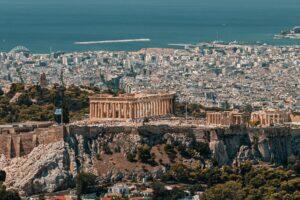Fodor's Expert Review Ancient Agora
The commercial hub of ancient Athens, the Agora was once lined with statues and expensive shops, the favorite strolling ground of fashionable Athenians and a mecca for merchants and students. The long colonnades offered shade in summer and protection from rain in winter to the throng of people who transacted the day-to-day business of the city, and, under their arches, Socrates discussed matters with Plato, and Zeno expounded the philosophy of the Stoics (whose name comes from the six stoas, or colonnades of the Agora). Besides administrative buildings, the schools, theaters, workshops, houses, stores, and market stalls of a thriving town surrounded it. The foundations of some of the main buildings that may be most easily distinguished include the circular Tholos, the principal seat of executive power in the city; the Mitroon, shrine to Rhea, the mother of gods, which included the vast state archives and registry office (mitroon is still used today to mean registry);... READ MORE
The commercial hub of ancient Athens, the Agora was once lined with statues and expensive shops, the favorite strolling ground of fashionable Athenians and a mecca for merchants and students. The long colonnades offered shade in summer and protection from rain in winter to the throng of people who transacted the day-to-day business of the city, and, under their arches, Socrates discussed matters with Plato, and Zeno expounded the philosophy of the Stoics (whose name comes from the six stoas, or colonnades of the Agora). Besides administrative buildings, the schools, theaters, workshops, houses, stores, and market stalls of a thriving town surrounded it. The foundations of some of the main buildings that may be most easily distinguished include the circular Tholos, the principal seat of executive power in the city; the Mitroon, shrine to Rhea, the mother of gods, which included the vast state archives and registry office (mitroon is still used today to mean registry); the Vouleuterion, where the council met; the Monument of Eponymous Heroes, the Agora's information center, where announcements such as the list of military recruits were hung; and the Sanctuary of the Twelve Gods, a shelter for refugees and the point from which all distances were measured.
The Agora's showpiece was the Stoa of Attalos II, where Socrates once lectured and incited the youth of Athens to adopt his progressive ideas on mortality and morality. Today the Museum of Agora Excavations, this two-story building was first designed as a retail complex and erected in the 2nd century BC by Attalos, a king of Pergamum. The reconstruction in 1953–56 used Pendelic marble and creamy limestone from the original structure. The colonnade, designed for promenades, is protected from the blistering sun and cooled by breezes. The most notable sculptures, of historical and mythological figures from the 3rd and 4th centuries BC, are at ground level outside the museum.
Take a walk around the site and speculate on the location of Simon the Cobbler's house and shop, which was a meeting place for Socrates and his pupils. The carefully landscaped grounds display a number of plants known in antiquity, such as almond, myrtle, and pomegranate. By standing in the center, you have a glorious view up to the Acropolis. Ayii Apostoloi is the only one of the Agora's nine churches to survive, saved because of its location and beauty. A quirky ruin to visit here is the 1st Century AD latrine in the northeastern corner.
On the low hill called Kolonos Agoraios in the Agora's northwest corner stands the best-preserved Doric temple in all Greece, the Hephaistion, sometimes called the Thission because of its friezes showing the exploits of Theseus. Like the other monuments, it is roped off, but you can walk around it to admire its preservation. A little older than the Parthenon, it is surrounded by 34 columns and is 104 feet in length, and was once filled with sculptures (the only remnant of which is the mutilated frieze, once brightly colored). It never quite makes the impact of the Parthenon, in large part due to the fact that it lacks a noble site and can never be seen from below, its sun-matured columns towering heavenward. The Hephaistion was originally dedicated to Hephaistos, god of metalworkers, and it is interesting to note that metal workshops still exist in this area near Ifestou Street.
READ LESS







